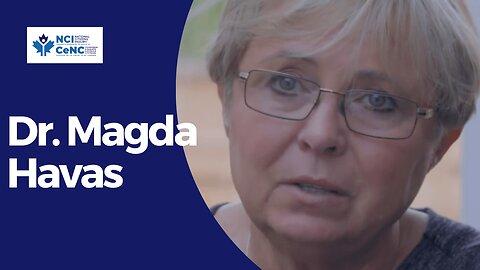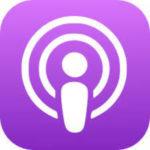Dr. Havas is an authority in environmental toxicology and its effects on the health of humans and other species. This presentation is on the possible connection between COVID-19 and radio frequency radiation. She reports that, “electromagnetic interference can cause electronics to operate poorly, malfunction or stop working completely. And it can also cause humans to operate poorly, malfunction, and stop working completely. That’s because we’re electromagnetic, as indicated by the activity of our brain and heart activity.”
* The above video is being streamed via Rumble. Check back often as we continue to update the complete list of links to all witness testimonies in both video and audio/podcast formats.
[00:00:00]
Shawn Buckley
We welcome you back to the National Citizens Inquiry as we continue our live hearing in Saskatoon. I’m pleased to announce our next witness, who is attending virtually: Dr. Magda Havas. Magda, can you hear me?
Dr. Magda Havas
I can.
Shawn Buckley
We see you on the screen and up in the corner and we’ve got your slide presentation. But I wanted to first of all ask if you could state your full name for the record, spelling your first and last name.
Dr. Magda Havas
Magda Havas, M-A-G-D-A H-A-V-A-S.
Shawn Buckley
And Magda, do you promise to tell the truth, the whole truth, and nothing but the truth, so help you God?
Dr. Magda Havas
I do.
Shawn Buckley
Now, I’m going to introduce you a little bit and then I’ll kick you loose to do the presentation. I will indicate for those participating that Dr. Havas’ CV is appended as Exhibit SA-1 and will be available online. It is 54 pages long. Dr. Havas, you’re a professor emerita at Trent University with expertise in environmental toxicology, is that right?
Dr. Magda Havas
That’s correct.
Shawn Buckley
And you’ve published on COVID-related illness and death. Your primary concern is the health of humans and other species related to environmental toxins.
Dr. Magda Havas
Yes.
Shawn Buckley
And my understanding is that you were one of the first scientists to identify the dangers of acid rain around 1970. You did this by traveling around the High Arctic in Canada, measuring the sulfuric acid in the water cycle from natural sulfuric vents in the Earth. And your early work was recognized by environmental activists, who lobbied for 15 years with you as their scientific advisor, and ended in Mulroney and Bush signing into law the US-Canada Air Quality Agreement known as the Clean Air Act?
Dr. Magda Havas
That’s correct. I was one of many scientists.
Shawn Buckley
Okay. Well, my source indicates you’re one of the first, so we’re going to run with that.
And after the work on acid rain, you became interested in electrical frequency effects on human health and lectured worldwide about it for two decades, along with your tenured position as professor at Trent University. And a few years ago, I’m told you had so many speaking requests for medical conferences that you took a one-year sabbatical, basically, to tour the world as a speaker on these topics.
So you’re nodding, but this is being recorded.
Dr. Magda Havas
Yes, yes.
Shawn Buckley
And I do that introduction just so that people appreciate that you are one of the world leaders on basically, environmental effects on humans and on basically, electromagnetic frequencies or radiations and their effects. So I’ll ask if you could proceed with what you had prepared for the Inquiry today [Exhibit SA-1b].
Dr. Magda Havas
Thank you very much.
I’d like to thank you for giving me this opportunity. And what I would like to talk about is a possible connection between COVID-19 and radio frequency radiation. And I’d like to start with four postulates. These are ideas or theories to start a discussion, all of which are based on scientific evidence.
Postulate 1 is that radio frequency radiation—and this is coming from a lot of our wireless technology—impairs the immune system, which increases the risk of infections. And this could lead to a higher case load and a higher death load.
Postulate 2 is that severe infections, which I call biological trauma, can increase sensitivity to radio frequency radiation and other toxins. And it could increase the risk of developing EMI. I call it EMI cubed.
EMI cubed stands for: electromagnetic interference, electromagnetic illness, and electromagnetic injury. If the interference is prolonged, it could relate in illness. And if the illness is severe it could result in injury. Injury can also be due to acute exposures to high levels of radiation.
The technical definition for electromagnetic interference is unwanted noise or interference in an electrical path or circuit caused by an outside source. EMI can be caused by natural and human-made sources. For example, lightning could be the source and your computer can be the victim. EMI can cause—
Shawn Buckley
Dr. Havas. Can I just stop you. Are you working through your slides? Because we’re still on your first one?
Dr. Magda Havas
Oh, I am.
Shawn Buckley
Okay, so that’s why I’m stopping you.
[00:05:00]
I’m not sure what’s happening because I think you’re screen sharing.
Dr. Magda Havas
I am.
Shawn Buckley
Because we just see the first slide that says, “COVID-19 and RFR—Is there a connection?”
Dr. Magda Havas
Okay that’s really weird. Okay, well I can give my presentation but the slides add enormously to it, so I’m not quite certain how to proceed.
Shawn Buckley
Okay. So on your computer, is it going through the slide presentation?
Dr. Magda Havas
It is, yes.
Shawn Buckley
One thing that we could do is, I believe I have your slide presentation. You could just tell me when to queue.
Dr. Magda Havas
Yes, I’ve changed it slightly.
Shawn Buckley
Oh, I see. Now you just changed the page there.
Dr. Magda Havas
What can you see now?
Shawn Buckley
“Possible confounding factors with COVID-19.”
Dr. Magda Havas
Oh, perfect. Okay. So maybe now it’s working? I can continue then.
Shawn Buckley
Yep.
Dr. Magda Havas
Okay, so I mentioned that electromagnetic interference can cause electronics to operate poorly, malfunction or stop working completely. And it can also cause humans to operate poorly, malfunction, and stop working completely. That’s because we’re electromagnetic, as indicated by the activity of our brain and heart activity.
Postulate number 3 is that the symptoms of COVID-19 are very similar to the symptoms of electromagnetic interference; they overlap considerably. And so it’s difficult from just the symptoms to determine what you have. Someone who has electromagnetic interference could actually be suffering from COVID. And someone who has COVID but perhaps has not been tested or tested negative, could be suffering from electromagnetic interference. And this is assuming that the tests are accurate and they haven’t always been.
During the lockdown, there was a deployment of 5G technology. So while the rest of us were staying in our homes, the telecommunication industry was very quickly erecting 5G antennas across the globe. And they coincided with the SARS-CoV virus. And we know that once the 5G technology is deployed, it causes an increase in radio frequency radiation that I’ll present in a few minutes. And that increases your risk of developing electromagnetic interference. And since we can’t tell the difference between the two, it’s difficult to know what people are suffering from.
Now, when we talk about epidemiology of a disease, there are three factors that are important. One is the agent, the other is the host, and the third is the environment. The agent can cause a disease or injury. It can be chemical, physical, or biological. And toxicity and dose are two important variables. In this particular case, SARS-CoV-2 is the agent.
The host is a human who experiences the health outcome. And the risk factors here are the health of your immune system, your genetics, and behavior, among others. And here we’re talking about COVID-19 and Long COVID.
The environment is an extrinsic factor that can affect the agent or the host and increase or decrease risk, severity, and duration of the health outcome. It can be physical, biological, socioeconomic, et cetera. And in this case, masking, social distancing, the closure of schools and businesses, your vitamin D3 levels and or exposure to sunlight are some of the environmental factors.
But it’s my opinion that some of these environmental confounding factors have not been adequately addressed when it comes to this pandemic. And I’d like to provide two examples. We know that ultraviolet light kills the virus, which benefits the host. We also know that radio frequency microwave radiation weakens the host and benefits the virus. And it’s my opinion that radio frequency radiation in the environment is a confounding factor that no one has addressed in any comprehensive way.
During the pandemic, I was busy looking at the data that was coming primarily from Johns Hopkins University but [also] a number of other organizations around the globe. And this is showing COVID-19 cases at the early stage of the pandemic. And one of the questions that I had was, why do levels of infection differ globally for this respiratory virus? And in an attempt to try to make sense of this,
[00:10:00]
I looked at various confounding factors that could be involved in this pandemic and posted that information on my website, trying to make sense of the COVID-19 pandemic with a global perspective.
And the first confounding environmental factor I looked at was population density. And here you can see population density in the figure at the bottom and the COVID-19 cases at the top. There were a number of anomalies. For example, the population in India and Africa are quite high, yet the number of COVID cases reported at the early stages was very low. And if we look at this graph that shows you population density along the x-axis and COVID-19 cases along the y-axis, you can see there’s a linear relationship with Africa falling slightly below the line. But if we add North America and Europe to this, it follows a very different trajectory. So there’s something else happening in North America and Europe to make so many people develop the virus.
Now, the map of COVID-19 more closely resembles Wi-Fi hotspots. And these are global Wi-Fi hotspots as of 2020 compared to April 7th, 2020 for the virus. And you can see here there are a number of similarities with very high levels in North America and Europe and very low levels in Africa and some of the other parts of the globe.
These are some of the confounding factors that I looked at: Population, the per cent elderly, since mostly people over the age of 80 were developing and dying. Air pollution and smoking because this is a respiratory virus. Tourism and air travel since that would indicate the spread of the illness. Various economic parameters that may differ from country to country. Various types of electromagnetic pollution, which is my area of research. And freedom of the press and internet censorship to ensure that the information we were getting was valid and wasn’t being censored.
And the conclusions I came up with was that there were some weak correlations. However, the scale was too large and there was a lack of data standardization. So I decided to focus on the United States data and I will be presenting some of that later in my presentation.
One of the questions circulating among electromagnetic experts in March of 2020 was: Is there a connection between the outbreak of COVID-19 and deployment of 5G networks around the world? And you may ask, why would we even ask this question? The reason is that SARS-CoV-2 outbreak and the deployment of 5G happened at the same time. So they overlapped spatially in time as well. Areas with high cases of COVID-19, for example, Wuhan, Northern Italy, and the Princess Cruise Line, all had recently deployed 5G technology. And we know that radio frequency radiation impairs the immune system, which could sensitize people to this viral infection.
And here’s an article, “Reaction of the Immune system to low-level radio frequency and microwave exposures.” And this is what the author concluded: that short-term exposure to weak microwave radiation may temporarily stimulate the immune functions, while prolonged exposure could inhibit the same immune functions. And this is not the only study. Dr. Henry Lai from the University of Washington reviewed the literature on neurological effects of radio frequency radiation published between 2007 and 2020. He found a total of 335 studies, three quarters of which—244—showed an effect of radio frequency radiation.
This paper just came out last year and it’s regarding the evidence of a connection between coronavirus disease and exposure to radio frequency radiation from wireless technology, including 5G [Exhibit SA-1d]. And what the authors concluded was that radio frequency radiation may cause morphological changes in erythrocytes, which are red blood cells, and Rouleaux formation—which I will talk about later—that can contribute to hypercoagulation. Radio frequencies can impair microcirculation and reduce erythrocytes and hemoglobin levels, exacerbating hypoxia. It can amplify immune system dysfunction, including immune-suppression, autoimmunity, and hyperinflammation. It can increase cellular oxidative stress and the production of free radicals,
[00:15:00]
resulting in vascular injury and organ damage. It can increase the amount of intracellular calcium—this is calcium within the cell—that’s essential for viral entry, replication, and release, in addition to promoting pro-inflammatory pathways.
Now we have inflammation mentioned twice here and we know that myocarditis—that’s been linked to both the virus and various vaccines, is inflammation of the heart muscle. And it can worsen heart arrhythmias and cardiac disorders. And what the authors recommend is that radio frequency radiation has become a ubiquitous environmental stressor that we propose may have contributed to adverse health outcomes of patients infected with SARS-CoV-2 and increase the severity of the COVID-19 pandemic. Therefore, we recommend that all people, particularly those suffering from viral infection, reduce their exposure to radio frequency radiation.
Now, does radio frequency and SARS-CoV-2 affect the blood? The answer to that question is yes. COVID-19 started as a respiratory infection and soon became a cardiovascular problem. The first doctor who reported this was an emergency doctor in New York, and he was fired for making the statement publicly.
Radio frequency radiation affects the cardiovascular system. And here is a publication that radiation from wireless technology affects the blood, the heart, and the autonomic nervous system [Exhibit SA-1f]. This is an example of live blood cells under darkfield microscopy. The person was in a very clean environment, and this is an example of healthy-looking blood. When that person was moved to a different environment that had a Wi-Fi router, they were exposed for 10 minutes and this is what their blood looked like after 10 minutes’ exposure. The cells are sticking together like a stack of coins. And this is called Rouleaux.
In this image, you can see that the blood is much more viscous. It’s more like ketchup rather than red wine. It has a reduced ability to infuse the body with oxygen. This places added pressure on the heart. And in the worst case, it can produce blood clots that can lead to heart attack or strokes, which we know are on the increase with COVID patients.
Here is another study published a year later. This time, instead of being exposed to Wi-Fi, a person was exposed to a cell phone, and you can see the Rouleaux formation in the middle slide. In the third slide—the oxidative stress—this is showing that the red blood cells have actually been damaged by the radiation, and many of them will die and need to be replaced.
Now, does radiofrequency radiation affect the heart? The answer to that is also yes. We did a provocation study where we exposed people to 2.45 gigahertz from a cordless phone base station and measured the effect on the autonomic nervous system. And this is what we concluded: Radiofrequency radiation can contribute to arrhythmia, which is an irregular heartbeat, or tachycardia, which is a rapid heart rate. And the definition for tachycardia is greater than 100 beats per minute. Radiofrequency can bring on an acute stress response by affecting the sympathetic and parasympathetic nervous systems, very similar to someone who has experienced a panic attack. And finally, some people think that they’re having a heart attack with added pain or pressure in the chest area.
We did an experiment with 25 volunteers initially and then we repeated it with 69 volunteers later on. And basically, a person participating in the study was lying down. They had a heart monitor attached to them that was attached to a computer. They were blinded so they didn’t know when they were exposed to the radiation or not. The radiation was placed just slightly above their head and either we plugged it into a live outlet, which caused the radiation, or we plugged it into a dead outlet that omitted the radiation completely.
And basically, what the technology does is it measures the time interval between heart rate—it’s called the R – R interval. And the longer this line is, the slower the heart rate; the faster it is, the shorter the heart rate. We used a power density of 30 microwatts per metre squared. You don’t have to worry about the units here, as I’ll use exactly the same units whenever I’m talking about this. That’s less than 1 per cent of Health Canada’s Safety Code 6, which is the guideline for radio frequency radiation.
[00:20:00]
Their guideline is 4.4 million microwatts per metre squared. And what I’m going to do is show you three patient results that are very, very similar.
Here we have subject A and they’re exposed to three intervals, each lasting between three and four minutes. This is their heart rate. In interval one, they were exposed to a sham, which means that there was no radiation. They were exposed to microwaves during interval two and a sham in interval three. And you can look at this and there’s virtually no difference. So this person is non-reactive. They’re not sensitive to this radiation.
This is a different subject, subject B, and you don’t have to be a cardiologist to see that this is having an effect. This is their heart rate. And remember, they’re lying down. They’re not moving. And yet their heart rate after the sham exposure increased from the 60s to 120. And this is an example of sudden onset tachycardia. This person is highly reactive and this is an example of electromagnetic interference.
The third example, subject C, was exposed to sham during intervals two and four, to microwaves during intervals three and five. And you can see there’s a slight increase in their heart rate and it’s very irregular. This person is reactive and they’re showing electromagnetic interference.
We also get information about the sympathetic and parasympathetic part of the autonomic nervous system. The sympathetic part is equivalent to the gas pedal on a car. And when it’s up-regulated, we go into the fight or flight or freeze mode. The parasympathetic represents the brakes of a car. And when it’s up-regulated, we have rest, digest, and heal. It was down-regulated for this individual. And when the parasympathetic is down-regulated, you’re unable to rest. Hence, people have difficulty sleeping. They can’t relax. They have digestive problems, and they have difficulty healing from any ailments that they may have. And this person virtually, while lying down, is having a panic attack. And this panic attack is physiological and not psychosomatic.
When doctors diagnose these patients, they think they have a mental problem, and they often recommend that the patient goes to a psychiatrist or a psychologist. And the psychiatrists are telling me that they’re being sent patients who have no psychological problem at all. So this is a physiological response.
Now, at the beginning of my presentation, I mentioned that I was going to look at data from the United States [Exhibit SA-1d]. And the United States collects some of the best data in the world, much better than even in Canada. And so here we’re looking at the COVID-19-attributed cases and deaths in the United States that relate to 5G. Now, 5G small cells are placed on streetlights, as you can see here, utility poles, and special poles entirely for supporting the 5G antennas. Electromagnetic scientists are very concerned about this rollout and they’re requesting that a moratorium be placed on further rollout of 5G. 5G is going to end up putting many more antennas on city streets because these antennas are placed roughly 100 metres apart. They’re going to be closer to buildings and to people. And this is going to increase the levels of radiation. The frequencies for 5G are over a very broad range from low all the way up to the high band. And the high band consists of something called millimetre waves. This is the first time millimetre waves have been used in telecommunication. And there have been absolutely no health studies looking at either people or the environment, despite the fact that they’re rolling it out.
And basically, what’s happening is that they’re conducting a global experiment very similar to vaccines. We’re told that 5G is safe—just like we were told that vaccines are safe and effective. Trust us. Well, there’s no evidence that we should trust the agencies allowing this to happen.
Now, here we have a map of COVID-19 cases in the United States as of September 18th. And we have deployment of 5G, also for the same date in September. And you can see here that it looks like there’s a relationship with high levels of deaths, or cases, and the amount of 5G deployment. But there’s a confounding variable and that is population density. If you have more people, you’re going to end up having more cases. And where you have dense populations,
[00:25:00]
that’s where the wireless industry is going to deploy their antennas to serve a larger population.
So we have to consider these confounders. And we did exactly that. The first time I looked at the United States data was on April 22nd. And I posted that information on my website. On May 31st, Angela Tsiang and I reassessed the data to see if it had changed. And this is what we got and this is what we also published: There were 18 states that did not yet have 5G millimetre waves deployed. And the average cases for these 18 states is 3,220 cases per million. So we’re standardizing for population. Thirty-three states had 5G millimetre wave antennas. And you can see that they have more than 5,000 cases per million, which gives you an excess of 2,556 cases per million. And that’s an 80 per cent increase. And these data are statistically significant.
We did the same thing for the death rate. And we found that there were 149 excess deaths per million. This was 95, 4 per cent higher. It was statistically significant. And this was roughly a doubling of the death rates for states that had 5G millimetre waves.
I mentioned earlier that the symptoms of COVID and the symptoms of electromagnetic interference are similar. So it’s very difficult to distinguish between the two of them. This is a survey that was conducted in 2003. So this was pre-5G and pre-COVID. And these are people who live at various distances from cell phone base stations. And here we have the symptoms. And here we have the percentage experiencing symptoms very often. These are the symptoms in decreasing order. And you can see there’s a massive overlap with symptoms that have been documented for COVID-19. And if we look at fatigue, for people that are within 10 metres—that’s the red—all the way out to beyond 300 metres—which is the black—there’s a huge difference, as there is for things like sleep disturbances. So these people are unable to sleep and hence they’re unable to recover and they end up having a lot of additional problems, difficulty concentrating, memory loss, et cetera.
Now, what happens to radio frequency levels with the introduction of 5G? Verizon places a map on their website that indicates where they’ve rolled out and where different types of technology is available for the American population. And you can zoom in on this map, which is what we did for Manhattan, New York. And we were interested in two parallel streets. The dark brown, here, is indicating that 5G millimetre waves have been deployed. So along Fifth Avenue, we have 5G and along Sixth Avenue, we don’t have 5G. We have a global set of volunteers: it’s called the Global EMF Network. We have over 400 volunteers from across the globe and we call them citizen scientists. So I asked one of our citizen scientists to measure these two avenues in Manhattan. And here we have the average, the median value, and the maximum value. The testing was done at five intersections and four street corners. So each of these numbers is based on 20 measurements. And you can see here that when 5G is deployed, the levels of radiation go up considerably. I’ve indicated the Russian guidelines and the Canadian guidelines to show you how different they are and to put this into perspective.
She also went and looked at Brooklyn, New York with very similar results, although the scale is different. So once 5G comes in, the levels of exposure go up significantly. And just as a reminder, the median value is a statistical value where half of the population or half of the samples fall below the median and half of the samples fall above the median up to the maximum. And in both cases, for Manhattan and Brooklyn, the median value exceeds the Russian guideline, whereas prior to that it didn’t.
Now, this is a case report for Sweden [Exhibit SA-1h]. And this is an apartment building where they replaced 4G and 3G antennas with 5G antennas.
[00:30:00]
And what I’m going to show you is the levels of exposure before the 5G antennas were erected with the 5G antennas. Now, this couple became so ill—I’ll share with you what they experienced—that they had to move. And so they actually moved to a different location and the levels of radiation were much lower. Eventually, they moved to a house in the country to get away from this radiation. This particular value was higher than what the meter could measure. And Health Canada’s guideline is 4.4. So Health Canada’s guideline was almost double this particular value. So Health Canada would tell you this is perfectly safe.
Now, this is information from the previous slide showing the place and date, as well as the amount of exposure. And here we have symptoms. In light blue, we have the number of symptoms experienced by the husband and wife. And in dark, we have the total symptom intensity. And these are the symptoms. You can see here with the asterisk: these overlap considerably with COVID symptoms. When 5G was deployed, the number of symptoms and symptom severity increased for the husband and they increased even more for the wife. She was simply unable to remain in this environment. And if you share this information with Health Canada, what they will say is that these exposures are below the Safety Code 6 guidelines. Therefore, they’re safe. And anyone—including pregnant women, children—can be exposed to them 24/7, which is absolute nonsense.
Our exposure to radio frequencies and microwaves have been increasing dramatically since the 1990s. It’s hard to believe but in 1995, less than 10 per cent of the Canadian population had cell phone subscriptions. And within a 20-year period, that increased to 82 per cent. And you can see a similar trend for many of the other countries. And whenever you have cell phones, you need to have cell phone antennas. And people who don’t even have a cell phone, don’t use a cell phone, are exposed to the radiation from a cell phone antenna. So in my mind, using a cell phone is like smoking, and living close to a cell phone antenna is like inhaling second-hand smoke.
This is a map I showed earlier showing Wi-Fi hotspots in 2020. Just 15 years earlier, there were very few Wi-Fi hotspots because they were used primarily by universities or research institutions—by the military in some countries. Now we have Wi-Fi everywhere in our homes. And I expect many of the people listening to this on their computers might be using Wi-Fi with their computers. We have them in schools, which is absolutely ridiculous. We have them in parks and hospitals, on airplanes. It’s very hard to get away from this. If we combine that with satellites and small cell antennas, which are both part of the 5G network, and smart meters and smart appliances and smart homes, you can see here that the levels of radiation are so much higher today than they were just 20 or 30 years ago.
Now there’s something very unusual when it comes to radio frequency guidelines. They vary by about seven or eight orders of magnitude globally, which is unheard of in toxicology. Whenever we have toxic limits for things like cadmium or lead in the environment, they’re very similar from country to country. And the guideline is the maximum permissible limit that people can be exposed to. And what I’ve done here is I’ve highlighted Canada and the city of Toronto, that have two very different guidelines. The lowest guideline shown here for the sleeping area in Germany is 100 times higher than the amount of radiation required by cell phones to operate.
So why these countries are allowing such high exposure limits when it’s not required for the technology is really very confusing and disturbing. These guidelines are based entirely on a heating effect. If it doesn’t heat your body, it’s not harmful. The heating is measured over a six-to-30-minute period. So it’s really giving you a short-term guideline of exposure. It was established by physicists and engineers and this was before we started using Wi-Fi and smartphones. So our environment has changed considerably, yet these guidelines remain relatively similar. And Health Canada is simply burying its head and not willing to consider the research in this area. And I’ll talk a little bit more about that in a minute.
[00:35:00]
We also have short-term guidelines. These are mostly for occupational settings. And then we have long-term guidelines, which are based on the precautionary principle. And these guidelines are much more recent. They’re more protective, obviously, and they were recommended by biologists and doctors who are studying the radiation effects.
Now, this study came out in 2020 showing that the lethality of COVID-19 is higher in countries that have a higher maximum permissible limit for radio frequency radiation. So we have some circumstantial evidence that there might be a relationship between the two.
What does the future hold for 5G technology? Well, this map shows you the estimated worldwide 5G adoption by mobile—by cell phones, basically. It’s excluding the internet of things, so it’s an underestimate. And what this map shows is that by 2021, we had 13 per cent adoption and by 2025—so within the next two years—that’s going to increase to 63 per cent. And that’s similar trends, once again, for other countries. Now, what the industry is most interested in is that 5G is the biggest growth-driver for smartphones and that 5G connections are to hit 1 billion this year. Plenty of room to grow. So what they’re really interested are the financial aspects.
Now, what does the future hold for electromagnetic interference? Well, if we use water as an analogy for our exposure, the people who are under the water are adversely affected. And the future doesn’t bode well if we end up doing nothing. The levels of radiation continue to increase and more people will be adversely affected. We really do have to reduce our exposure. Having a moratorium on 5G is one way to do it, but we need to go even beyond that. We can reduce levels so that very few people, if any, are adversely affected by this radiation. And my motto is: if it doesn’t move, it doesn’t need to be wireless. So the smart meter on your home can be wired, it doesn’t need to be wireless. The Wi-Fi computer doesn’t need to use Wi-Fi; it can be connected to an ethernet connection.
What does the future hold for vaccines? Well, according to Pfizer, the number of doses estimated to be administered in 2023 is 65 million in the United States and, by 2026, 98 million. So they are continuing to move ahead on ensuring that everyone in the population is vaccinated. The motivating force is obviously the revenue that they get from this virus.
Now, how serious a problem is this? How many people are affected? We believe that about 3 per cent have severe sensitivity and another 35 per cent have moderate sensitivity. And if we look at Toronto and Ontario and Canada, we’re talking about a million people in Canada who could be adversely affected because of this radiation due to their sensitivity. And we know that those who are moderately affected, it impairs the quality of life. The next viral outbreak is going to affect these people the most— These are the most vulnerable. And it’s going to reduce the tolerance of those who are moderately affected to other stressors they might have in their lives.
Now, I’ve done this for other provinces and territories. In Saskatchewan, 30,000 people are likely to be severely affected and almost 400,000 with mild to moderate sensitivity. With 5G, this is going to increase substantially. Now, who is helping these million people or 13 million people with mild sensitivity? It’s certainly not the government, because they don’t even recognize this as an illness and their guidelines certainly don’t protect anyone. It’s not the industry, because they’re the ones contributing to the problem. It’s basically volunteers. So we have volunteers, mostly in Canada, but some around the globe who are helping these individuals. And you can’t help a million people with just volunteers.
We need resources for research on how to diagnose and treat those who are ill. We need to educate and train medical professionals, since this isn’t taught in medical school. We need to establish green zones for safe housing because people simply cannot live in the middle of a city that has all of these antennas.
We have to make accommodations for them in hospitals and schools and in the workplace, showing these different organizations how to reduce exposure.
[00:40:00]
We need to set up monitoring programs because the government is not monitoring our exposure—unlike some of the air quality monitoring they do and fish toxins that they monitor for eating fish. And we need to set up a 24-hour hotline because a number of these people are so desperate that they’re considering MAID, which is medical assistance in dying.
In 2010 and 2015, there was a House of Commons Standing Committee on Health and they made a number of recommendations. And I’d like to just read one of the recommendations from the 2010. It says, Health Canada “ensure that it has a process in place to receive and respond to reports of adverse reactions to electromagnetic radiation-emitting devices.” And this is very similar to the vaccine adverse events reporting that was requested. In 2015, the committee met with different people populating it, and they came up with 12 recommendations. I’m not going to read them, but I’d like them to be in the records [Exhibit SA-1i].
This is Health Canada’s and Environment Canada’s response to those two HESA meetings: “Health Canada has determined that exposure to radio frequency electromagnetic energy below their guidelines is not dangerous, and no further updates are required.”
And Environment Canada said they are reviewing the science and this was updated in 2018. However, the committee asked for not only a review but for a report as well. And it’s my understanding that these reports do not exist. The government is not following the wishes and the recommendations of HESA. And by the way, you can still listen to the HESA meetings with the questions that were asked very similar to what you’re doing with the National Citizens Inquiry.
I have a number of recommendations and they apply to different organizations. We need to establish a moratorium on 5G deployment. We have to replace wireless technology with wired technology—and that is simply bringing fibre to the premises or to the last mile, which is what appears in the literature. We have to limit wireless to mobile devices, because basically we’re conducting a global experiment very similar to the experiment that’s being conducted with vaccines and it’s going to result in excess deaths.
In the meantime, everyone needs to reduce their exposure to radio frequency radiation, especially those with Long COVID. And once again, this can be done by replacing wireless technology with wired technology in your home. And I use the acronym FIND: reduce your frequency of use, reduce the intensity. The closer you are to these devices, the higher the levels of exposure. So don’t place your cell phone next to your head, don’t place your cell phone in your bra and minimize your duration of exposure.
It’s important that governments listen to experts rather than Big Pharma or Big Tech. They need to implement the recommendations of the House of Commons Standing Committee on Health and Radio Frequency Radiation.
My advice for the media is that they should remain independent of government and economic backers. They should provide unbiased information and they should not ridicule or silence those who have divergent views.
And I guess one of my major concerns is with medical regulators. They have unchecked power that needs to be investigated and moderated. They are a captured agency. We have a number of examples of how they misused their power by firing doctors who were saving lives with ivermectin. I have one example from the electromagnetic field area and that is: doctors who diagnose you with electromagnetic hypersensitivity can lose their medical license because it’s not recognized. This illness is not recognized by our medical regulators.
We need to encourage scientists and doctors to freely discuss and debate different perspectives. Debate is a strength, not a weakness, of the scientific method. And it’s difficult to know who should you trust. My advice is don’t trust anyone who’s doing research for political or economic gain.
And finally, I think we have to establish a special foundation to fund research, training, and support for those who are vulnerable. And we can do this by posing a $1 surcharge for each cell phone subscription. This would provide a sustainable budget of $34 million annually in Canada. And we might consider doing the same thing on each vaccine injection,
[00:45:00]
to help those who have been damaged by the vaccines.
“Our lives begin to end the day we become silent about things that matter.” This is one of my favorite quotes and I try to live by it in my personal and academic life. I think it’s very important to speak truth to power. Those who hold principled power welcome truth. Those who want unconstrained power fear truth and they try to silence us. What we have just experienced can be disempowering and it can make us fearful. It can make us collectively [fearful] or it can make us collectively and individually much wiser and stronger. It all depends on what we do next.
May wisdom and compassion prevail. We need to stop this insanity. If not us, who? If not now, when? Thank you for giving me this time.
Shawn Buckley
Dr. Havas, you also did a survey of Canadians concerning COVID mandates. Can you quickly share that with us?
Dr. Magda Havas
Yes. And can you see that okay?
Shawn Buckley
Yeah, you could, yes.
Dr. Magda Havas
Are you seeing this or not?
Shawn Buckley
Yeah, we see “What do Canadians think and want regarding the COVID mandates.” Although you could go full screen because we still, on the left, see your list of slides.
Dr. Magda Havas
Okay, I am full screen, and it seems like it’s not doing it again. Hold on.
Can you see that now?
Shawn Buckley
Yeah, we see, thank you.
Dr. Magda Havas
Oh, okay. No, I’m sorry. Let me try one more time. I’ll try a new share. No, you can’t see that?
Shawn Buckley
Well, we see “Time Line: Emergencies Act, Survey, Senate Vote.”
Dr. Magda Havas
Okay, great. Let me just get rid of this. You can see that, that’s great.
So just a very quick timeline. I was very interested in what was happening in Ottawa with the convoy. I was deeply concerned about the mandates and I was also concerned about the Emergencies Act. And so I decided that once the Emergencies Act was called on February 14th, I was curious to see how many people supported the government and how many people supported the truckers. Among my own colleagues and friends and family, there was a divide. I had people on both sides. And so I designed a survey and released it online on February 16th [Exhibits SA-1a, SA-1c].
The survey went viral. We had more than 90,000 responses to it. And we closed it on the 20th of February. I posted the information on my website on the 21st. And the Senate had a debate on the 22nd on the Emergencies Act, which we know was revoked. And I sent the senators a copy of the of the survey because I thought it was important that they know how 90,000 Canadians felt. However, a few days later, I received a note saying that the recipient had refused my email. So the government website did not accept my email to senators. And I don’t know if this is legal or not, but that’s what happened to me.
There were a total of 10 questions, eight of which were multiple choice, two of which were open ended, which means people could say whatever it is that they wanted. And these are some of the survey results, and I’ll share them with you very quickly. Most people were Canadian citizens, 98 per cent. A few were landed immigrants. And I assume some of these weren’t Canadian citizens either. So most of them were Canadian citizens.
“I support the way the premier of my province has handled the COVID situation.” In this survey, people were not very happy with the way their premiers handled the situation.
[00:50:00]
When it came to where these people were located, most of them were from Ontario, Alberta, and British Columbia. And that accounted for about 70 per cent. We had a few that didn’t live in Canada. And we even had some representation from northern part of Canada.
One of the questions was, “I support the Trucker Convoy.” And the answer to that was “yes,” with a very large percentage.
“I support Prime Minister Trudeau’s Emergencies Act.” And a very large percentage does not support this. So this survey seems to be internally consistent. You would expect if they support one, they wouldn’t necessarily support the other.
Here I asked a question about the mandates and whether or not people supported the mandates. Most of the people did not support the mandates. I asked, “When would you like the mandates to end?” Most of them said immediately. And about just under 6 per cent said, “When the government says so.”
“Which of the mandates do you think need to be ended?” Here we have all of them for about 82 per cent. And this is one of the questions that won’t add up to 100 per cent, and that’s because you could answer multiple ones. So you could answer the vaccine booster and the vaccine passport, but not some of the others. So this is the only question that doesn’t add up to 100 per cent.
We also, in the two open-end questions. “So how has the mandate affected your life?” Seventy-nine thousand people answered this. And this is a word cloud. The larger the font, the larger the word, the more often it’s represented. And you can see some of the words here. Family, unable, anxiety, depression, vaccine. And when I asked, “How has the trucking convoy affected your life?” We have the word hope, we have brave, convoy, country, gave, made, truckers, that sort of thing.
And I just have two pages of each of the question, open-ended questions. And I just want to draw your attention that there were 3,391 pages of answers to the open-ended question number nine about the mandate. People who responded positively to the mandate are shown in blue and people who responded negatively are shown in red. And here we have the same thing for the trucking convoy: positive responses in blue, negative responses in red, with a few people saying, “it hasn’t affected me at all.”
Now, a month later—let me just see if I can do this. A month later, the CBC requested a poll. This was also an online poll with about 2,500 Canadians. And it was, as I mentioned, about two weeks later. And this was an Angus Reid Forum poll. And I looked up Angus Reid Forum. Basically what they do is they pay people to answer their surveys. Now, if they randomize the people they send the survey to, this is perfectly valid.
But if you see here, just two weeks later, people who thought that Trudeau was doing a good job or a very good job are just under 50 per cent. So there’s a real match here: totally contradicts what we got in my survey. And this is CTV News in October and November, so it was several months later. They asked whether people would support a return of the mandatory mask mandate. And 69 per cent said they would and 30 per cent said they wouldn’t. So once again, we’re getting very different results.
While I used to trust mainstream media, it’s not something I trust anymore. And so one critical question: Is my survey representative of Canadians? The answer to that is, I don’t know. It was distributed online. It went viral and we had a very large sample size, which is good, which is what you want in a survey. But I don’t know if there was a distribution bias. And by that I mean: Did people send it primarily to friends who thought the same way they did? And if they did, then this would invalidate the survey representing the rest of Canada. All I can say is the survey did represent the 93,135 people who responded. And I’m sharing this because I want their voices to be heard.
Thank you.
Shawn Buckley
Dr. Havas, thank you very much for sharing that. And I’ll just ask the commissioners if they have any questions for you. And there are questions.
Commissioner Massie
Thank you very much for your presentation. I’m very curious about the sensitivity to the radiation
[00:55:00]
that varies quite dramatically from one individual to the other. This is measured by symptoms that we can actually monitor. Is there any other, I would say, biomarker that can be monitored that would give us some sort of a more direct measurement based on a putative mechanism of action of these radiation on people?
Dr. Magda Havas
There are a number of biomonitors that you can— How do I stop sharing? Sorry.
So there are some biomonitors. For example, we notice that people who are diabetic: if they’re diabetic and they’re sensitive to the radiation, their levels of blood sugar will increase. And it will increase within a very short period of time, within about 10 to 15, 20 minutes. And if you move them into an electromagnetically clean environment, their blood sugar drops. And we know that when diabetics are stressed physically or physiologically or psychologically, that’s what happens. So they go into the fight-or-flight response and that increases blood sugar.
We’ve done work with people who have multiple sclerosis and we found that if we place them in a clean environment, some of their symptoms go away: the tremors, the brain fog, that sort of thing. Oxidative stress is one of the most studied markers, so anything that would tell you the levels of enzymes in your body that are increasing oxidative stress. And if you take any antioxidants, you can relieve some of your symptoms.
So there are various biomarkers in that regard that we can determine whether or not someone is actually suffering from electromagnetic exposure. And then of course, there’s the blood; you can measure the blood and it goes into Rouleaux. And you can see the oxidative damage in the red blood cells at the same time.
Commissioner Massie
I have another question. Are you aware of I would say, large-scale studies—epidemiological studies—that would actually quantify that more specifically in population, or is it just that there are some correlations that we establish? But what I mean by epidemiological study: Has there been study where you would monitor specific biomarkers in population to correlate their increase with the level of exposure?
Dr. Magda Havas
Most of the epidemiological studies have focused on cancer and on reproductive problems. We know it damages sperm, for example, and there have been a number of studies looking at that. And there’s an increase in things like brain tumors, breast cancer for women who store their phone in their bra. There’s evidence of other types of cancers associated with the head and the face: salivary gland tumors, cancer or tumor of the ear, that sort of thing. So those studies have been done and our Canadian government, members of Health Canada, have been involved in those studies. So they’re aware of the research, yet they’re deciding not to incorporate any of that in their guidelines.
And indeed, the International Agency for Research on Cancer, as of 2011, classified radiofrequency and microwave radiation as a possible carcinogen. So it was a Class 2B carcinogen. So we have that for cancers. We have that for sperm damage. There are fewer studies— There are some epidemiological studies but not looking at biomarkers, just looking at symptoms in blinded individuals, so they didn’t know why they were part of a study. And then we have clinical trials as well, where clinically they’re exposed and blindly tested. And we have evidence of that as well.
Commissioner Massie
So in terms of the damage, is it proportional to the time of exposure?
Dr. Magda Havas
It can be. It turns out that when people first started reporting sensitivity, it was often associated with their use of a cell phone. And what they found was that they started getting heat; they could feel heat coming from the cell phone. And then their fingers would go numb. And they started getting headaches. And the headaches only lasted after they had been on the phone for a little bit of time.
[01:00:00]
And it went away as soon as they took the phone away.
And what tends to happen over time is that the latency is shorter for the symptoms. The symptoms become more severe and they end up lasting much longer. So by the time that you start testing individuals who have experienced this for a few months or possibly a few years, you expose them to the radiation and they’ll have symptoms for days or weeks afterwards. And it won’t go away. And that’s what’s beginning to happen to that very small— One to three per cent of the population are in that particular category.
Commissioner Massie
So if we would want to reduce the exposure to people with these towers, anything that you would put to physically shield the population from that would interfere presumably with the transmission of the wave and then reduce the signal. Is that the issue?
Dr. Magda Havas
The towers are a serious problem if you live close to them. And that’s why the 5G small cell towers are going to be absolutely devastating for the population.
There is material that you can buy to shield your home. There’s film you can put on your windows that’s made by 3M, and it will reduce the levels of exposure by about 90, 95 per cent. You can also get triple-E glass windows that are very energy efficient and they seem to have the same effect; they reduce exposure. And indeed, high rise buildings near the CN Tower in Toronto won’t be built unless they have that special triple-E glass because the levels of radiation in those condominiums or office buildings would be way too high. There’s paint you can put on your wall that will reduce the exposure. There’s fabric that you can get that uses either copper or silver fibre in them and people make a canopy over their bed to minimize their exposure so they can at least sleep at night. And sometimes they’ll make curtains for their windows—and this is translucent, so it still lets the light in. There’s clothing that’s available. Some people will put the fabric I just mentioned in a baseball cap and they’ll wear it. And they tell me that they don’t get a headache then if they use their cell phone. So it shields their head from the cell phone radiation.
Commissioner Massie
You mentioned that during the lockdowns there was a big campaign to install these G5 towers. To what extent did the lockdown facilitate the establishment of these, or the building, deployment of these tower?
Dr. Magda Havas
Oh, it made a huge difference. People would wake up and sometimes they installed these towers in the middle of the night and so you’d wake up and the next morning there’d be a tower outside your home that wasn’t there the day before. So they were taking advantage of the rest of us being locked down and not witnessing what was happening.
The towers that have been erected have been making people sick and they’re now complaining to their municipal board of health about it because they have to approve the sighting of these locations. But unfortunately, they just don’t have the amount of funding required to take the industry to court if they’re unwilling to remove a tower that’s causing adverse health effects. And a lot more lawyers are beginning to get involved in this and I think there’s going to be quite a bit of litigation as a result of the harmful effects of this radiation.
Commissioner Massie
I’m very concerned by this very wide range of the acceptable level of radiation across countries. Is there any initiative going on to standardize that at the international level?
Dr. Magda Havas
Unfortunately, there’s a group called ICNIRP [International Commission on Non-Ionizing Radiation Protection]. And they’re a group of industry-funded scientists, mostly physicists and engineers, who work out of Germany. And they’ve been advising the World Health Organization. The World Health Organization, this particular branch that deals with radio frequency and microwave radiation is a captured agency just like the FCC and, to a certain degree, Health Canada. So they’re abiding by the recommendations from ICNIRP and the ICNIRP recommendations are among the worst in the world, as you can imagine.
Other countries have decided that they’re not going to abide by the ICNIRP recommendations,
[01:05:00]
or what the World Health Organization recommends and they’re setting their own guidelines. And some of the most protective ones are actually in parts of Europe and other parts of the world, including Russia. Russia did research on this very early on, using it both from a health perspective, using frequencies to promote health, and using them as a weapon. So they looked at it from both sides and they have moderately safe guidelines. I’d say they’re not nearly as safe as some of the other countries in Europe that have now instigated the precautionary principle. And I showed you the results for Germany.
The most critical environment in everyone’s home is their bedroom. If they can at least get a good night’s sleep and levels of radiation are low, their body can recuperate and recover. But if the levels are high in the bedroom, then ultimately your health is going to be impaired with various chronic illnesses.
Commissioner Massie
Maybe one last question. Is there a device that would allow us to monitor the level of radiation in different rooms in our house?
Dr. Magda Havas
Yes. They’re not very expensive either. There’s various companies— I don’t know if I can mention them on this program but there are companies in Canada that sell meters. Some of the less expensive ones are under $200. And actually, one of the things I recommend is that people buy meters, that they put them in libraries, for example, or doctor’s offices and loan them to their patients so they can go home and measure the levels of radiation. Because if you don’t know what you’re exposed to, you can’t minimize your exposure. So measuring the levels are absolutely critical for this. And meters are readily available and aren’t very expensive.
Commissioner Massie
Thank you very much.
Dr. Magda Havas
Thank you.
Shawn Buckley
And there’s some more questions.
Commissioner Drysdale
You talked about, and I saw in your slide you showed, a representation of antennas on towers, on light standards, et cetera. How do we recognize these? How do we differentiate them from the cell phone towers we’re used to seeing? And lastly have these got anything to do with all of our lights turning purple?
Dr. Magda Havas
Well, actually, they’re putting some of the technology in lights as well. So some of the streetlights will have Wi-Fi in them as well and that’s causing problems. They have a different—slightly different size and shape.
But sometimes you can’t tell where the antennas are because they’re hidden. They’re hidden in flags, for example, so you’ll have a mast with a flag on it, and inside that mast are the antennas that are for 3G, 4G, 5G. The 4G antennas tend to be rectangular, so they have a rectangular shape and they tend to go into a third of a 120-degree angle. And you have three of them if you want to cover the 360-degree circumference.
Along a highway, they’ll have one facing one way and one facing the other way to cover the traffic. You can differentiate between whether it’s 3G, 4G, 5G by the shape of the antenna. And you can get information on a website. I actually give a lecture on cell towers and antennas. And that’s available on my YouTube channel and it gives you the basic information of what you need to know about antennas.
Commissioner Drysdale
Just, I guess, an ordinary person’s question. I mean when I pick up my cell phone and I want to watch a movie on it— I don’t do that but, if I want to, it works. So why are we going to 5G when what we have seems to work for what most of us need it for?
Dr. Magda Havas
I agree. The excuse the company—or the reason the company—is giving, is that they’ll have much faster computing time. So for things like self-propelled cars, driverless cars, you will need a very fast reaction time and that’s the direction that they’re heading towards.
If these cars become available, then people won’t be able to drive them who are electrically sensitive because it will just screw them up mentally and psychologically and physically. It’ll just make them too ill. And as a matter of fact, a lot of the cars now are already have so much Bluetooth Wi-Fi in them that people are getting sick.
And so what the companies are saying is that we need this fast-computing power for these driverless cars,
[01:10:00]
for the internet of things. We don’t even know what some of the future technology will look like. We need it for facial recognition, which is another issue that deals with our privacy, for example. We need it for things like operating at a distance. So you’ll be able to set up— Someone will be able to operate and they’re in one city and the patient is in another city and it’s all done in a wireless fashion. I’d hate for something to go wrong during that operation if it was done in a wireless fashion.
And I think it’s just a sexy thing for people to do. They love the fact that they can walk around with this little cell phone, which is basically a minicomputer, and they can do so much with it. But you can keep it off most of the time. You can turn on your airplane mode, turn your Wi-Fi and Bluetooth off, and you can still listen to music if you have it on the device. And you can still take photographs, you can still do a lot of things.
There are devices now where you can actually hook up your cell phone—you can wire your cell phone through the equivalent of an ethernet cable and still do a lot of things. You can make phone calls, everything else by doing it in a wired way rather than a wireless way.
Commissioner Drysdale
I’m not sure why we need driverless cars when we’re going to be in 15-minute cities.
Thank you.
Dr. Magda Havas
I agree.
Shawn Buckley
There are no further questions, Dr. Havas. On behalf of the National Citizens Inquiry, we sincerely thank you for your testimony today and sharing with us.
Dr. Magda Havas
Thank you very much.
[01:11:56]
Final Review and Approval: Jodi Bruhn, August 21, 2023.
The evidence offered in this transcript is a true and faithful record of witness testimony given during the National Citizens Inquiry (NCI) hearings. The transcript was prepared by members of a team of volunteers using an “intelligent verbatim” transcription method.
For further information on the transcription process, method, and team, see the NCI website: https://nationalcitizensinquiry.ca/about-these-transcripts/
Credentials
- B. Sc. Honors Biology, University of Toronto 1971-1975
- Ph.D. Department of Botany & Institute for Environmental Sciences, University of Toronto, 1975-1980
Summary
Dr. Havas is an Environmental Toxicologist, with a PhD and post doctoral research at Cornell University. Electromagnetic interference is unwanted noise or interference in an electrical path or circuit caused by an outside source. It can cause electronics to operate poorly or malfunction. It can also cause humans to malfunction because we are electromagnetic as indicated by the activity of the brain and heart. Dr. Havas posited a potential connection between COVID-19 and radio frequency radiation. She presented two scenarios: One: that radio frequency radiation from wireless technology can impair the immune system, which increases the risk of infections and could lead to a higher caseload and more deaths; Two: that severe viral infection can increase sensitivity to radio frequency radiation and other toxins.
Dr. Havas pointed out that many 5G antennas were installed around the world during lockdowns in 2020. A map of COVID-19 hotspots closely resembles WI-FI hotspots. 5G technology creates a substantial increase in radio frequency radiation and greater risk of electromagnetic interference. Governments and regulators are ignoring the poor health outcomes people are suffering because of increased RFR exposure (non-ionizing radiation). She believes that 5G rollouts are a global experiment similar to that of the novel mRNA COVID injections. The medical profession does not yet recognize electromagnetic hypersensitivity as a health hazard, yet researchers in the field believe that 3% of the population have severe sensitivity and another 35% experience moderate sensitivity.
Dr. Havas recommends a moratorium on 5G rollout, replacing wireless technology with wired tech. She said, “We have to limit wireless to mobile devices because basically, we’re conducting a global experiment very similar to the experiment that’s been conducted with vaccines and it’s going to result in excess deaths.”






















